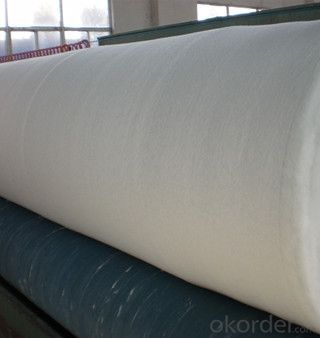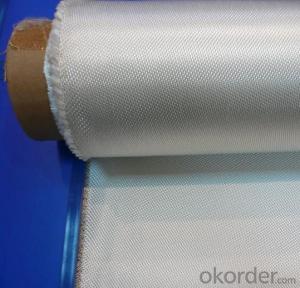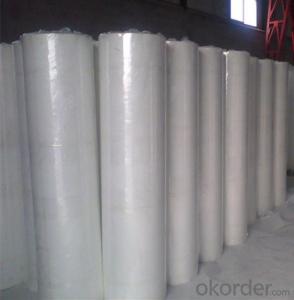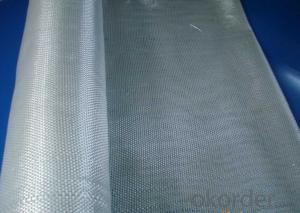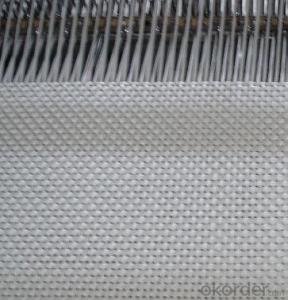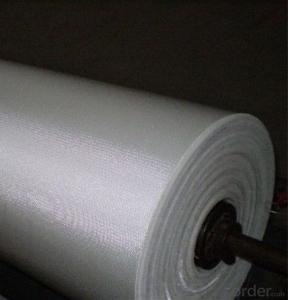Fiberglass Yarn Reinforced Fiberglass Fabric of Different Specifications
- Loading Port:
- Shanghai
- Payment Terms:
- TT OR LC
- Min Order Qty:
- 500 m²
- Supply Capability:
- 50000 m²/month
OKorder Service Pledge
OKorder Financial Service
You Might Also Like
Fiberglass Fabric of Different Specification
Fiberglass Fabric Introduction:
Fiberglass fabric is weaved by high quality fiberglass,as a kind of engineering material,which is
many excellent characteristics:
flame-resisting,corrosion resistant,high strength,heat resistance.stable structure,good chemical resistance,durability.
Fiberglass Fabric Features:
Warp and weft yarns are parallel arrangement as flat situation, with uniform tension;
Fiber is aligned with large consistency, stable and easy operation;
Good moldability, fast and complete wet out in resins, resulting in high productivity;
Good transparency and high strength of composite products.
Fiberglass Fabric Specification:
mark | Fiber consistency(ends/ cm) |
Area weight (g/ m2) |
Thick-ness (mm) |
Width (cm) |
Length (mm) | Breaking strength(N)≥ |
weave | |||
Warp direction | Weft direction | Warp direction | Weft direction | |||||||
EW200 | 16 | 12 | 200±20 | 0.2 | 90-130 | 300-1200 | 980 | 980 | ||
EW210 | 16 | 12 | 200±20 | 0.21 | 90-130 | 300-1200 | 1080 | 1080 | Twill weave | |
Plain weave | ||||||||||
EWR360 | 3.2 | 1.8 | 354±18 | 0.35 | 50-300 | 100 | 2000 | 2000 | ||
EW280 | 16 | 10 | 280±28 | 0.26 | 90-130 | 300-1200 | 1800 | 1800 | ||
EW300 | 14 | 10 | 320±32 | 0.3 | 90-130 | 300-1200 | 1500 | 1500 | ||
EW430 | 20 | 12 | 420±42 | 0.43 | 90-130 | 300-1200 | 2000 | 2000 | Broken twill | |
EWR136 | 10 | 10 | 136±13 | 0.136 | 100 | 200 | 850 | 850 |
Plain weave | |
EWR200 | 8 | 7 | 200±20 | 0.21 | 100 | 200 | 1200 | 1200 | ||
EWR400 | 3.6 | 3.2 | 400±30 | 0.4 | 100 | 50-100 | 2500 | 2500 | ||
EWR600 | 2.6 | 2.5 | 600±50 | 0.6 | 100 | 40KG | 4000 | 4000 | ||
EWR580 | 2.5 | 2.3 | 576±29 | 0.58 | 100 | 40KG | 3850 | 3850 | ||
EWR800 | 1.8 | 1.8 | 800±60 | 0.8 | 100 | 40KG | 4600 | 4600 | ||
Product Show


Fiberglass Fabric Usage:
E-glass woven roving is a schistose double faces reinforcement fabric that is weaved into from roving in directly.
E-glass fiber fabric (thin fabrics with thickness from 0.025 to 0.09mm) is suitable for electrical isolation mica product, wax cloth as the reinforcement materials.
E-glass woven roving applys to all kinds of polyester reinforcement system, (such as unsaturated polyester resin, vinylite,epoxy resin and phenolic resin.
E-glass woven roving is a high performance reinforcement material. It is widely used in hand lay-up and machinery processing products, (such as vessel, container, airplane and vehicle component, furniture, athletic facilities and other industry.
FAQ
1.Package of Fiberglass Fabric?
Fiberglass fabric is wound on a paper tube with inner diameters of 50. 8, 76 or 152mm. Each roll is wrapped in a plastic bag, then to be packed in a carton box. The rolls are to be horizontally placed.
Width (cm): 90, 100, 127
Length (m): 100, 200, 300, 400
2.Storage of Fiberglass Fabric?
Store rolls in a cool, dry location
Protect rolls from weather and other damage.
3.If sample available if needed?
We aim to offer our customer best Products&Service,samples are allowed if necessary.
- Q: Can fiberglass yarn be used in shipbuilding?
- Yes, fiberglass yarn can be used in shipbuilding. Fiberglass yarn is a strong and lightweight material, making it suitable for various applications in the marine industry. It is commonly used in shipbuilding to reinforce composite materials, such as fiberglass-reinforced plastic (FRP) composites. These composites are used to construct boat hulls, decks, and other structural components, providing them with increased strength and durability. Fiberglass yarn is also resistant to corrosion, which is an important characteristic for materials used in shipbuilding. Overall, fiberglass yarn is a versatile material that can be effectively utilized in the construction of ships and other marine vessels.
- Q: Is fiberglass yarn resistant to oils and greases?
- Fiberglass yarn is renowned for its ability to resist oils and greases. Its inherent properties grant it a high level of resistance against the effects caused by these substances. Due to its low affinity for oils and greases, fiberglass yarn does not readily adhere to or allow penetration by these substances. This resistance factor renders fiberglass yarn an excellent choice for applications where contact with oils and greases is anticipated, such as in the production of industrial filters, gaskets, or protective clothing. Furthermore, the durability and longevity of fiberglass yarn are enhanced by its resistance to oils and greases, as it is less susceptible to degradation or weakening when exposed to these substances.
- Q: Can fiberglass yarn be used for wind turbine manufacturing?
- Indeed, wind turbine manufacturing can utilize fiberglass yarn. Fiberglass yarn, a robust and enduring material, is widely employed in various industries, including aerospace, automotive, and construction. Its exceptional strength-to-weight ratio and resistance to corrosion render it an ideal substance for fabricating wind turbine components. Within the realm of wind turbine manufacturing, fiberglass yarn is employed to craft composite materials, such as fiberglass-reinforced plastics (FRP), which are commonly employed in constructing wind turbine blades. Typically, the fiberglass yarn is woven into a fabric and combined with a resin matrix to form a lightweight yet sturdy composite material capable of withstanding the forces and stresses experienced by wind turbine blades. Utilizing fiberglass yarn in wind turbine manufacturing offers numerous advantages. Firstly, fiberglass boasts non-conductive properties, which are crucial for wind turbines that operate in high-voltage environments. Additionally, fiberglass exhibits resistance against environmental factors like moisture, UV radiation, and temperature fluctuations, making it exceptionally durable and suitable for long-term outdoor usage. Moreover, fiberglass yarn can be readily manipulated and molded into intricate shapes, enabling the production of aerodynamically optimized wind turbine blades. The flexibility of fiberglass yarn also facilitates the design and manufacturing of longer blades, which can harness more wind energy and enhance the overall efficiency of the wind turbine. Ultimately, fiberglass yarn proves to be a fitting material for wind turbine manufacturing due to its strength, durability, non-conductive characteristics, and ease of fabrication. Its utilization in wind turbine blade production contributes to the advancement of more efficient and dependable wind turbines that play a vital role in generating clean and renewable energy.
- Q: How does the dimensional stability of fiberglass yarn compare to other materials?
- The dimensional stability of fiberglass yarn is generally higher compared to other materials.
- Q: Is fiberglass yarn resistant to rot?
- Yes, fiberglass yarn is resistant to rot.
- Q: Can fiberglass yarn be used in the production of ropes and cords?
- Yes, fiberglass yarn can be used in the production of ropes and cords.
- Q: Is fiberglass yarn suitable for making automotive seat covers?
- Yes, fiberglass yarn is suitable for making automotive seat covers. Fiberglass is a strong and durable material that can withstand the wear and tear that automotive seat covers are subjected to. Additionally, fiberglass yarn is resistant to heat, chemicals, and UV rays, making it well-suited for use in vehicles. It also has excellent dimensional stability, meaning it retains its shape and resists stretching or shrinking over time. These qualities make fiberglass yarn a reliable choice for automotive seat covers, ensuring they can withstand the demands of daily use and offer long-lasting durability.
- Q: Is fiberglass yarn suitable for making outdoor furniture covers?
- Fiberglass yarn is indeed a suitable option for crafting outdoor furniture covers. This material, known for its durability and resilience, can effectively endure various outdoor elements like sunlight, rain, and temperature fluctuations. It also possesses resistance against mold, mildew, and pests, rendering it an exceptional choice for covers that must withstand these challenges. Furthermore, fiberglass yarn is lightweight and effortless to manipulate, making it an ideal material for crafting removable covers that can be conveniently stored when not in use. All in all, fiberglass yarn proves to be a practical and dependable alternative for manufacturing outdoor furniture covers that offer enduring protection for your cherished pieces.
- Q: How does fiberglass yarn perform in corrosion resistance?
- Fiberglass yarn performs exceptionally well in corrosion resistance. Thanks to its non-reactive and non-corrosive properties, it is highly resistant to the effects of corrosion caused by chemicals, moisture, and other corrosive elements. This makes fiberglass yarn a reliable choice for applications that require long-lasting and durable corrosion resistance, such as in the construction of pipes, tanks, and other infrastructure exposed to harsh environments.
- Q: Can fiberglass yarn be used in the production of electrical tapes?
- Fiberglass yarn, with its high thermal resistance and electrical insulation properties, is a suitable material for the production of electrical tapes. By incorporating fiberglass yarn into the tape, it adds reinforcement, strength, and durability, making the tape resistant to high temperatures, electrical currents, and mechanical stress. Furthermore, the inclusion of fiberglass yarn improves the tape's dielectric properties, thereby enhancing its electrical insulation capabilities. As a result, fiberglass yarn is widely utilized in the manufacturing of electrical tapes.
Send your message to us
Fiberglass Yarn Reinforced Fiberglass Fabric of Different Specifications
- Loading Port:
- Shanghai
- Payment Terms:
- TT OR LC
- Min Order Qty:
- 500 m²
- Supply Capability:
- 50000 m²/month
OKorder Service Pledge
OKorder Financial Service
Similar products
Hot products
Hot Searches
Related keywords



